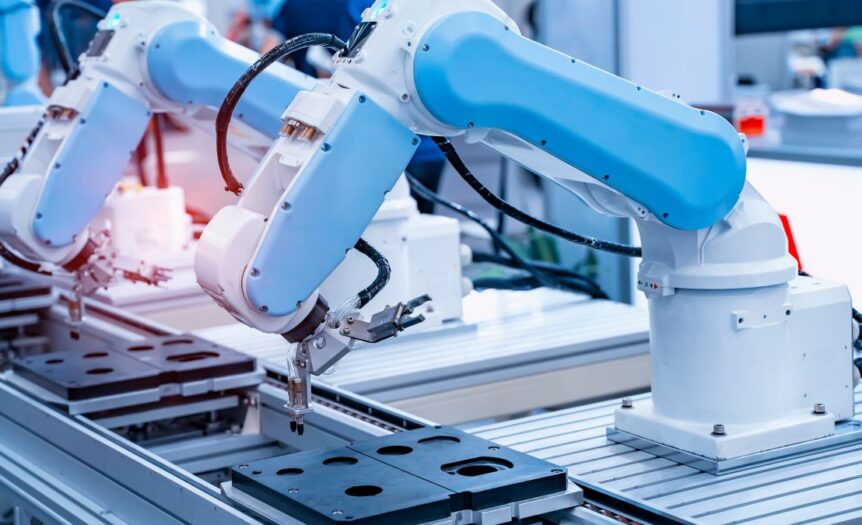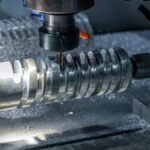In today’s fast-paced and highly competitive manufacturing landscape, improving productivity and efficiency is essential for survival and growth. This era uses rapid technological advancements to meet changing consumer demands and the constant pressure to reduce costs while improving quality. To thrive, manufacturers must adopt innovative strategies, leverage new technologies, and continuously seek ways to optimize operations.
Let’s look at ways to improve productivity and efficiency in manufacturing.
Automation and Robotics
Automation and robotics have revolutionized the manufacturing industry. Manufacturers can significantly increase productivity by automating repetitive tasks while reducing labor costs. Robots are becoming more accessible to smaller businesses, and their flexibility allows them to perform a wide range of tasks with precision and speed. From assembly line operations to material handling, robots can streamline processes and improve manufacturing efficiency. With advancements in artificial intelligence, robots can even learn to perform more complex tasks, making them an indispensable tool for improving productivity.
Lean Manufacturing
Lean principles have become a staple in the manufacturing industry. The focus is on continuously reducing waste and optimizing processes to increase efficiency. Manufacturers can significantly improve productivity by streamlining workflows, eliminating unnecessary steps, and implementing standardized procedures. Lean manufacturing also promotes a culture of continuous improvement that encourages employees to identify and eliminate inefficiencies in their daily work. This step increases efficiency and helps create a more engaged and motivated workforce.
Predictive Maintenance
Equipment downtime is one of the biggest productivity killers in manufacturing. Production delays from unexpected breakdowns can result in tremendous losses. Predictive maintenance uses sensors and data analytics to monitor equipment performance and predict when maintenance is necessary. This proactive approach helps manufacturers schedule maintenance during planned downtime, reducing the likelihood of unexpected breakdowns and increasing productivity.
Cloud Computing
The adoption of cloud computing has transformed many industries, including manufacturing. By storing data on remote servers, companies can access information from anywhere at any time, increasing collaboration and efficiency. With cloud-based solutions, manufacturers can streamline processes and reduce paperwork, leading to productivity gains. Cloud computing also allows for real-time data analysis, providing insights that can help identify areas for improvement.
Employee Training and Safety
Well-trained and safe employees are essential for a productive manufacturing environment. Employees who receive proper training are more knowledgeable, engaged, and efficient in their roles, leading to increased productivity. Additionally, using machine guarding and personal protective equipment (PPE) can help prevent accidents resulting in costly downtime. By investing in employee training and safety measures, manufacturers can create a culture of productivity and efficiency.
In the relentless pursuit of improving productivity and efficiency, today’s manufacturing enterprises must stay agile and innovative. These five strategies can help manufacturers reduce costs and stay ahead of the competition. As technology continues to evolve and consumer demands change, manufacturers must continuously seek ways to improve their processes and operations for long-term success.





 Deering Estate
Deering Estate
 Massage Envy South Miami
Massage Envy South Miami
 Calla Blow Dry
Calla Blow Dry
 My Derma Clinic
My Derma Clinic
 Sushi Maki
Sushi Maki
 Sports Grill
Sports Grill
 The Healthy Kitchen
The Healthy Kitchen
 Golden Rule Seafood
Golden Rule Seafood
 Malanga Cuban Café
Malanga Cuban Café

 Kathleen Ballard
Kathleen Ballard
 Panter, Panter & Sampedro
Panter, Panter & Sampedro
 Vintage Liquors
Vintage Liquors
 The Dog from Ipanema
The Dog from Ipanema
 Rubinstein Family Chiropractic
Rubinstein Family Chiropractic
 Your Pet’s Best
Your Pet’s Best
 Indigo Republic
Indigo Republic




 ATR Luxury Homes
ATR Luxury Homes


 2112 Design Studio
2112 Design Studio
 Hamilton Fox & Company
Hamilton Fox & Company
 Creative Design Services
Creative Design Services
 Best Pest Professionals
Best Pest Professionals
 HD Tree Services
HD Tree Services
 Trinity Air Conditioning Company
Trinity Air Conditioning Company
 Cisca Construction & Development
Cisca Construction & Development
 Mosquito Joe
Mosquito Joe
 Cutler Bay Solar Solutions
Cutler Bay Solar Solutions


 Miami Royal Ballet & Dance
Miami Royal Ballet & Dance
 Christopher Columbus
Christopher Columbus
 Pineview Preschools
Pineview Preschools
 Westminster
Westminster
 Carrollton
Carrollton
 Lil’ Jungle
Lil’ Jungle
 Frost Science Museum
Frost Science Museum
 Palmer Trinity School
Palmer Trinity School
 South Florida Music
South Florida Music
 Pinecrest Orthodontics
Pinecrest Orthodontics
 Dr. Bob Pediatric Dentist
Dr. Bob Pediatric Dentist
 d.pediatrics
d.pediatrics
 South Miami Women’s Health
South Miami Women’s Health

 The Spot Barbershop
The Spot Barbershop
 My Derma Clinic
My Derma Clinic




 Miami Dance Project
Miami Dance Project

 Rubinstein Family Chiropractic
Rubinstein Family Chiropractic
 Indigo Republic
Indigo Republic

 Safes Universe
Safes Universe
 Vintage Liquors
Vintage Liquors
 Evenings Delight
Evenings Delight





 Atchana’s Homegrown Thai
Atchana’s Homegrown Thai
 Baptist Health South Florida
Baptist Health South Florida

 Laser Eye Center of Miami
Laser Eye Center of Miami
 Visiting Angels
Visiting Angels
 OpusCare of South Florida
OpusCare of South Florida

 Your Pet’s Best
Your Pet’s Best





 HD Tree Services
HD Tree Services
 Hamilton Fox & Company
Hamilton Fox & Company


 Creative Design Services
Creative Design Services